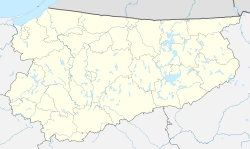Święta Lipka
Święta Lipka [ˈɕfjɛnta ˈlipka] (German: Heiligelinde), in English: Holy Linden, is a small village in the administrative district of Gmina Reszel, within Kętrzyn County, Warmian-Masurian Voivodeship, in northeastern Poland.[1] It lies approximately 6 kilometres (4 mi) south-east of Reszel, 13 km (8 mi) south-west of Kętrzyn, and 55 km (34 mi) north-east of the regional capital Olsztyn. The village has a population of about 200 and was part of East Prussia until the end of World War II. Święta Lipka is known for the pilgrimage sanctuary and temple, a masterpiece of Baroque architecture, and its moving pipe organ, one of the finest and most unique church instrument ever made.
Święta Lipka | |
|---|---|
Village | |
 | |
 Święta Lipka  Święta Lipka | |
| Coordinates: 54°2′N 21°13′E | |
| Country | |
| Voivodeship | |
| County | Kętrzyn |
| Gmina | Reszel |
| Population | 200 |
Sanctuary of St. Mary

According to legend, the name Heiligelinde and Święta Lipka - Holy Linden (lime tree) - referred to a tree with a wooden statue of Mary under which miracles took place; a legend exists that a convicted criminal carved a figurine of Mary and was released soon-after. As a sign of gratitude he placed the miraculous figurine on a linden tree, which had healing properties. The actual origin of the name may stem from a sacred grove of the Old Prussians.
A chapel at the site was first mentioned in a 1491 deed issued by Johann von Tiefen, then Grand Master of the Teutonic Knights. At this time Heiligelinde was already a pilgrimage site, with an inn. It was destroyed about 1525 during the Protestant Reformation, during which the region gradually became more Lutheran.
Although the village lay in the Protestant region of Masuria, the Roman Catholic faith was again approved in the Duchy of Prussia in 1605.[2] The chapel was rebuilt by the Jesuits and consecrated in 1619 by the Warmian prince-bishop Szymon Rudnicki and became a popular pilgrimage site among the Roman Catholic populace of the surrounding counties as well as the Lutheran Masurians.[2]
References
- "Central Statistical Office (GUS) - TERYT (National Register of Territorial Land Apportionment Journal)" (in Polish). 2008-06-01.
- Ossowski, Miroslaw (2007). Ostpreussen - Westpreussen - Danzig: eine historische Literaturlandschaft (in German). Jens Stüben. p. 384. ISBN 978-3-486-58185-0. Retrieved 2009-10-28.
External links
- (in Polish) Official site
- Święta Lipka Jesuits
| Wikimedia Commons has media related to Święta Lipka. |
